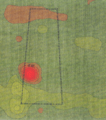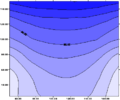Exhumation of Yagan's head facts for kids
The exhumation of Yagan's head was a special project in 1997. It involved using science to study the ground and an archaeological dig at a grave in Everton Cemetery, Liverpool. Yagan was an Aboriginal warrior who lived in Australia. He was killed in 1833 by British settlers in Perth. This happened because he resisted the British settlements in the Swan Valley, Western Australia. Yagan's death removed a big challenge for the growing British Empire in Western Australia.
Contents
Who Was Yagan?
Yagan was an Indigenous Australian warrior from the Noongar people. He was important in the early resistance against European settlers in the Perth, Western Australia area. In 1833, a young settler named James Keates shot Yagan.
After Yagan died, his head was removed and preserved using smoke. A man named Robert Dale took the head to England. He gave it to the Liverpool Institute, where it was put on display in a museum.
By 1964, Yagan's head was in poor condition. So, it was decided to bury it. The head was placed in a plywood box. A Peruvian mummy and a Māori head were also buried with it. They were all buried in Everton Cemetery, in General Section 16, grave number 296.
Later, more burials happened around this grave. In 1968, a local hospital buried 20 stillborn babies and two babies who had lived less than twenty-four hours directly over the museum box.
For many years, members of Perth's Noongar community wanted Yagan's head back. They wished to bury it according to their traditional customs. In 1994, they asked for permission to dig up the head. However, this was not allowed. This was because they could not get permission from the families of the twenty-two babies buried there.
Finding Yagan's Head with Science
In 1997, the Home Office asked two brothers, Dr. Martin Bates and Dr. Richard Bates, to help. Dr. Martin Bates was from the University of Wales, Lampeter, and Dr. Richard Bates was from the University of St Andrews. Their job was to use special scientific tools to survey the grave site. The goal was to dig up Yagan's head from a nearby plot without disturbing the other burials.
The brothers used two main methods:
- Ground Penetrating Radar: This tool sends radar waves into the ground. It helps create a picture of what's beneath the surface. However, it did not work well here. The graveyard soil had been disturbed a lot, which created many confusing signals.
- Ground Conductivity: This method measures how well electricity moves through the ground. The measurements showed something unusual in the ground's electrical signal. Scientists thought this might be caused by metal objects buried with the head. This finding suggested that they could reach the head from a nearby plot.
Next, a pit was dug in an empty plot next to the grave. It went down about 1.8 meters (6 feet). From inside this pit, they did another ground conductivity test. This test did not show the same unusual signal found earlier. However, the conductivity map did show something odd in the center of the grave. This suggested that the grave was only dug to its full depth of 2.7 meters (9 feet) in the middle. This supported the idea that a small box had been buried there. It also matched what the grave digger remembered about building a small box for the buried remains.
Digging Up the Head
After gathering all the information about where Yagan's head was and how deep it was, Dr. Bates gave his report to the Home Office. Eventually, permission was given to dig up the head.
Yagan's head was dug up by tunneling sideways into the grave from the pit next door. This tunneling was "delicate and risky." The tunnel went underneath where the babies were buried. Any collapse could have disturbed their remains.
According to Richard Bates, the first dirt from the grave showed signs of the decayed box. Then, the Peruvian mummy appeared, followed by the Māori head, and finally, Yagan's head.
The next day, a forensic palaeontologist from the University of Bradford confirmed it was Yagan's skull. They did this by matching fractures on the skull to descriptions in a report from 1834 by Thomas Pettigrew.
What Happened Next?
Later that year, Yagan's head was given to a group of Noongar people. They took it back to Australia. The reburial of the head was delayed for a while. This was because they were not sure where the rest of his body was. Also, there was some disagreement among elders about whether the head needed to be buried with the body.
Finally, in July 2010, Yagan's head was buried. This happened in a traditional Noongar ceremony in the Swan Valley in Western Australia. This was 177 years after Yagan's death.
Images for kids






